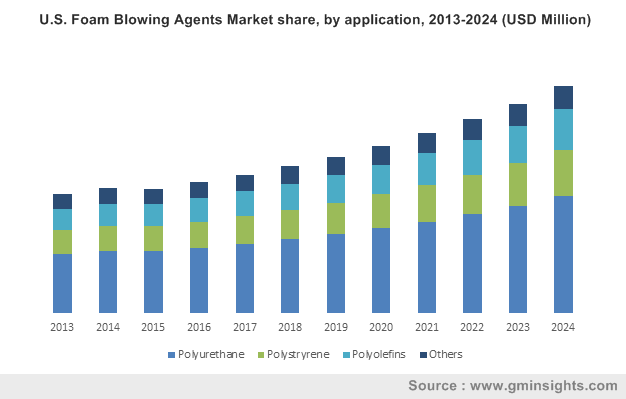Foam Blowing Agents Market Outlook: Construction sector to witness major adoption over 2016-2024
Publisher : Fractovia | Published Date : 2017-02-24Request Sample
Foam Blowing Agents Market has witnessed a radical change owing to the introduction of low Global Warming Potential (GWP) and zero Ozone Potential Depletion (OPD), which have paved the way to the widespread use of non-flammable and non-toxic foam blowing agents. Their importance can be attributed to the fact that they provide a strong cellular structure in various materials and are the key ingredients in foam substrates. According to Global Market Insights, Inc., “Foam blowing agents industry registered a revenue of more than USD 600 million in 2015 and is forecast to register a CAGR of 7% over 2016-2024.”
Foam blowing agents are used in polymeric foam production to upgrade foam properties, leading to its increased applications in the construction, hospitality, flooring, and packaging sectors. An ever-increasing demand for polymeric foam, driven by its advantages of less material usage, reduced product weight, and thermal insulation will fuel industry growth.
U.S. Foam Blowing Agents Market share, by application, 2013-2024 (USD Million)

Considering global trends, Asia Pacific takes the cake, dominating almost half of the foam blowing agents market in the world. Key regions that contribute to this immense growth include Thailand, Vietnam, India, and South Korea. Other contributing factors are high technological advancements, excellent infrastructure, and industrialization.
Europe contributes to around 15% of the overall revenue generation of the foam blowing agents industry. This growth can be credited to the region’s highly developed industries, which include frozen food packaging, automobiles, and automotive components, such as steering wheels, car seats, door panels, and windows. Besides, Europe has witnessed a high development in the healthcare sector, which is on a further rise due to increased awareness regarding medical devices.
North America is expected to portray an upsurge in the foam blowing agents market in the years to come, driven by its strong presence in the food packaging and pharmaceutical domains, not to mention, the ever-developing healthcare industry.
Vital applications of the foam blowing agents industry include polyurethane foams, polystyrene foams, and polyolefins foams. Polyurethane foams are widely used in the construction, hospitality, furnishing, packaging and automobile industries. Excellent infrastructure and advanced technology contribute to high growth in the construction sector. On similar lines, a high income coupled with an improved standard of living drives the hospitality domain, indirectly fueling further growth in the foam blowing agents market.
Polyolefins applications depicted a significant rise in the packaging industry, especially in the manufacture of shock absorbent product packing. This application segment was worth more than USD 90 million in 2015 and is predicted to have a healthy growth over 2016-2024.
In terms of product, foam blowing agents can be classified into hydrocarbons, Hydrochlorofluorocarbons [HCFC], and Hydrofluorocarbons [HFC]. Hydrocarbons contribute to more than 50% of the foam blowing agents industry share and the market is anticipated to grow at an annual rate of more than 7% CAGR over 2016-2024. This product finds uses in the automobile, furnishing, flooring, and appliance industries, to name a few.
Other products include methyl formate, water, azodicarbonamide, methylal, and inert gases, and contribute to more than 15% in the foam blowing agents market. The overall growth of this sector is noteworthy, despite a lesser contribution to the overall market share.
The global foam blowing agents industry is dominated by a few selective giants, namely ZEON Corporation, Haltermann GmbH, Sinochem Group, DuPont, AkzoNobel N.V., Arkema S.A., Daikin Industries Ltd., ExxonMobil Corporation, Solvay S.A., and Honeywell. The market is extremely competitive, owing to the global presence of these companies across multiple processes.
Foam blowing agents are widely used in environment-friendly products. This market has widespread applications in automotive, furnishings, packaging, hospitality, and construction sectors, and is predicted to grow extensively in the years to come.